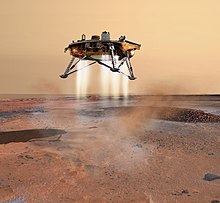NASA's Phoenix spacecraft lands safely on Mars
Monday, May 26, 2008

Image: Corby Waste (Jet Propulsion Laboratory/NASA).
NASA's Phoenix spacecraft has landed safely on Mars, following a ten-month flight. Landing occurred yesterday evening at around 23:38 GMT (20:38 EDT), with confirmation being received by flight controllers around fifteen minutes later at 23:53, the communications delay due to the time taken for light and radio signals to travel from Mars back to Earth.
Phoenix was launched atop a Delta II rocket last August. It is the first Mars Scout spacecraft to be sent to explore Mars. It will search for water and complex molecules at the North Pole of Mars. It is the third spacecraft currently operating on Mars, joining the Mars Expedition Rovers Spirit and Opportunity, which are currently operating on the planet's surface. Phoenix is expected to operate on the surface of Mars for 90 Martian days, about 92 Earth days.
Scientists monitoring the landing at the Jet Propulsion Laboratory in Pasadena, California cheered as the news was transmitted by the spacecraft, saying it had landed safely.
According to the live broadcast on NASA TV, a systems check began in final preparation for landing at 22:20 GMT (7:20 p.m. eastern time) which was given the "all green". At 22:22, Phoenix was confirmed to be properly aligned for entry into the Martian atmosphere. At 22:30 Phoenix began to accelerate into the atmosphere, where it will hurtle towards the planet at nearly 11,000 miles an hour. At 22:41 the data stream was successfully sent to Earth, Phoenix successfully separated from its boosters and sent a UHF signal to NASA. At 22:44 its main radio was confirmed to be on.
Scientists monitoring the MRO then confirmed the signal from Phoenix at 22:45. Approximately 3 minutes later Phoenix was confirmed to have entered the Martian atmosphere.

Image: NASA/JPL.
According to predictions before the landing - based on the sequence of events programmed into onboard computers - the cruise stage, which had controlled the spacecraft during its journey from Earth to Mars, separated from the probe which was to enter the atmosphere at 23:24:15 GMT. Entry interface occurred at 23:31:15, and the parachute deployed at 23:34:58. The heat shield was jettisoned at 23:35:13, followed by the rest of the "aeroshell", which had protected the spacecraft during decent, and the parachute, at 23:37:13. Landing itself occurred at 23:38:36 GMT.
During descent, the spacecraft's progress was monitored by the Mars Reconnaissance Orbiter and 2001 Mars Odyssey spacecraft, already in Areocentric orbit. Mars Odyssey was in contact with Phoenix throughout the descent, including during the phase of the descent where maximum temperatures were reached, when controllers had predicted that data would be lost. The HiRISE camera on Mars Reconnaissance Orbiter was able to photograph Phoenix under its parachute during descent.
Phoenix's goal is to gather environmental information about Mars to search for possible locations for the best signs of microbial life in the soil. It will also research the history of water on Mars. The mission is scheduled to last for at least 92 Earth days, or 90 Martian days.

The spacecraft landed in an area near the North Pole of Mars, unofficially named the Green Valley. It is an area about 250 kilometres wide, located in the Vastitas Borealis plains.
Phoenix is carrying a number of instruments to investigate Mars. Some of these were taken from the cancelled 2001 Mars Surveyor lander, and some others were derived from instruments flown on the Mars Polar Lander (MPL) spacecraft. MPL was launched in January 1999, but failed during its descent to the Martian surface. Landing on Mars is considered to be one of the most difficult challenges in space exploration, and one scientist working on today's landing said that "this is not a trip to Grandma's for the weekend". More than half of previous missions to Mars have failed, leading to jokes that exploration of the planet is cursed.
This is the 38th spacecraft to be launched to Mars, and the 19th to arrive successfully, bringing the success rate to exactly 50 percent. It is also the 12th spacecraft to attempt a landing on Mars, and the 7th to successfully accomplish this.
Upon confirmation of landing, a flight controller was heard to exclaim "The Phoenix has landed, welcome to Vastitas Borealis!", whilst others cheered, and congratulated each other on the successful landing.
Sources
- "NASA spacecraft lands on Mars" — KDBC, May 25, 2008
- "Live broadcast" — NASA TV, May 25, 2008
- Justin Ray. "Mission Status Center" — Spaceflight Now, May 25, 2008
- "NASA's Phoenix lands successfully on Mars" — NASASpaceflight.com, May 25, 2008
- Brent Shockley. "Phoenix Landing Day Blog" — NASA, May 25, 2008